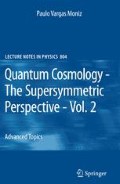Abstract
Following on the appraisal presented in Chap. 2 of Vol. I, the reader may rightfully be asking: Given the framework of quantum cosmology (QC), where are the boundaries of our knowledge, i.e., what exactly constitutes these limits? What are the best directions to move in, and in particular, what predictions or (falsifiable) tests for the universe can be made using quantum cosmology?
Access this chapter
Tax calculation will be finalised at checkout
Purchases are for personal use only
Notes
- 1.
For the momentum constraints (2.2) at this order, we obtain
$$h_{ij}{\,^{(3)}\nabla}_k\left({\frac{\updelta{{S_0}}}{\updelta{{h_{ik}}}}}\right)=0\;.$$((2.7)) - 2.
- 3.
Up to this order, the total wave functional thus reads
$$\varPsi\approx\frac{1}{\mathcal{K}}\exp\left({{\textrm i}} \textbf{M}S_0[h_{ab}]/\hbar \right) {\mathcal{F}} [h_{ab},\phi]\;,$$((2.12))where \({\mathcal{F}}\) satisfies the Schrödinger equation.
- 4.
‘Time’ is thus defined through the chosen solution S 0 of the Hamilton–Jacobi equation. However, \(\boldsymbol{\tau}\) is not a spacetime scalar. Nevertheless, the semi-classical scheme can be implemented with the (functional) Schrödinger equation found by integrating (2.14) over three-dimensional space.
- 5.
Note that \(\breve{\sigma}_2\) is a pure gravitational term.
- 6.
Minisuperspace coordinates \(q^X\) are treated as (semi)classical, while the perturbations constitute quantum mechanical quantitities.
- 7.
Compare with the Born–Oppenheimer approximation, where ignoring the off-diagonal terms amounts to assuming a decoherence process.
References
Barvinsky, A.O., Kamenshchik, A.Yu., Kiefer, C., Mishakov, I.V.: Decoherence in quantum cosmology at the onset of inflation. Nucl. Phys. B 551, 374–396 (1999)
Barvinsky, A.O., Kamenshchik, A.Yu., Kiefer, C.: Effective action and decoherence by fermions in quantum cosmology. Nucl. Phys. B 552, 420–444 (1999)
Barvinsky, A.O., Kiefer, C.: Wheeler–DeWitt equation and Feynman diagrams. Nucl. Phys. B 526, 509–539 (1998)
Giulini, D., et al.: Decoherence and the Appearance of a Classical World in Quantum Theory, p. 366. Springer, Heidelberg (1996)
Giulini, D., Kiefer, C., Zeh, H.D.: Symmetries, superselection rules, and decoherence. Phys. Lett. A 199, 291–298 (1995)
Giulini, D., Kiefer, C.: Consistency of semiclassical gravity. Class. Quant. Grav. 12, 403–412 (1995)
Giulini, D., Kiefer, C., Lammerzahl, C. (eds.): Quantum Gravity: From Theory to Experimental Search, p. 400. Springer, Heidelberg (2003)
Kiefer, C.: Decoherence in quantum electrodynamics and quantum gravity. Phys. Rev. D 46, 1658–1670 (1992)
Kiefer, C.: Quantum Gravity. International Series of Monographs on Physics, vol. 136, 2nd edn., pp. 1–308. Clarendon Press, Oxford (2007)
Kiefer, C.: Continuous measurement of minisuperspace variables by higher multipoles. Class. Quant. Grav. 4, 1369 (1987)
Kiefer, C.: Continuous measurement of intrinsic time by fermions. Class. Quant. Grav. 6, 561 (1989)
Kiefer, C.: How does quantum gravity modify the Schrödinger equation for matter fields? Class. Quant. Grav. 9, S147–S156 (1992)
Kiefer, C., Polarski, D.: Emergence of classicality for primordial fluctuations: Concepts and analogies. Annalen Phys. 7, 137–158 (1998)
Kiefer, C., Polarski, D., Starobinsky, A.A.: Quantum-to-classical transition for fluctuations in the early universe. Int. J. Mod. Phys. D 7, 455–462 (1998)
Kiefer, C., Singh, T.P.: Quantum gravitational corrections to the functional Schrödinger equation. Phys. Rev. D 44, 1067–1076 (1991)
Kiefer, C., Luck, T., Moniz, P.: The semiclassical approximation to supersymmetric quantum gravity. Phys. Rev. D 72, 045006 (2005)
Moniz, P.V.: Origin of structure in a supersymmetric quantum universe. Phys. Rev. D 57, 7071–7074 (1998)
Kiefer, C.: The semiclassical approximation to quantum gravity. gr-qc/9312015 (1993)
Halliwell, J.J., Hawking, S.W.: The origin of structure in the universe. Phys. Rev. D 31, 1777 (1985)
Halliwell, J.J.: Introductory lectures on quantum cosmology. In: Proceedings of Jerusalem Winter School on Quantum Cosmology and Baby Universes, Jerusalem, Israel, 27 December 1989–4 January 1990
Padmanabhan, T., Singh, T.P.: On the semiclassical limit of the Wheeler–DeWitt equation. Class. Quant. Grav. 7, 411–426 (1990)
Wiltshire, D.L.: An introduction to quantum cosmology. In: Robson, B., Visvanathan, N., Woolcock, W.S. (eds.) Cosmology: The Physics of the Universe, Proceedings of the 8th Physics Summer School, A.N.U., January–February 1995, pp. 473–531. World Scientific, Singapore (1996). gr-qc/0101003 (1995)
Birrell, N.D., Davies, P.C.W.: Quantum Fields in Curved Space, p. 340. Cambridge University Press, Cambridge (1982)
Bertolami, O., Moniz, P.V.: Decoherence of Friedmann–Robertson–Walker geometries in the presence of massive vector fields with U(1) or SO(3) global symmetries. Nucl. Phys. B 439, 259–290 (1995)
Hu, B.L., Verdaguer, E.: Stochastic gravity: Theory and applications. Living Rev. Rel. 11, 3 (2008)
Hu, B.L., Sinha, S.: A fluctuation–dissipation relation for semiclassical cosmology. Phys. Rev. D 51, 1587–1606 (1995)
Sinha, S., Hu, B.L.: Validity of the minisuperspace approximation: An example from interacting quantum field theory. Phys. Rev. D 44, 1028–1037 (1991)
Bouhmadi-López, M., Moniz, P.V.: Quantisation of parameters and the string landscape problem. hep-th/0612149 (2006)
Bousso, R.: Precision cosmology and the landscape. hep-th/0610211 (2006)
Hartle, J.B., Hawking, S.W.: Wave function of the universe. Phys. Rev. D 28, 2960–2975 (1983)
Vilenkin, A.: Quantum creation of universes. Phys. Rev. D 30, 509–511 (1984)
Vilenkin, A.: Creation of universes from nothing. Phys. Lett. B 117, 25 (1982)
Vilenkin, A.: Boundary conditions in quantum cosmology. Phys. Rev. D 33, 3560 (1986)
Vilenkin, A.: Quantum cosmology and the initial state of the universe. Phys. Rev. D 37, 888 (1988)
Vilenkin, A.: Approaches to quantum cosmology. Phys. Rev. D 50, 2581–2594 (1994)
Page, D.N.: Lectures on quantum cosmology. In: Mann, R.B., et al. (eds.) Proceedings of Banff Summer Institution on Gravitation, Banff, Canada, 12–15 August 1990, pp. 135–170. World Scientific, Singapore (1991)
Page, D.N.: Quantum cosmology lectures. gr-qc/9507028 (1994)
Page, D.N.: Aspects of quantum cosmology. gr-qc/9507025 (1995)
Page, D.N.: Quantum cosmology. hep-th/0610121 (2002)
Author information
Authors and Affiliations
Corresponding author
Rights and permissions
Copyright information
© 2010 Springer-Verlag Berlin Heidelberg
About this chapter
Cite this chapter
Moniz, P.V. (2010). ‘Observational’ Quantum Cosmology. In: Quantum Cosmology - The Supersymmetric Perspective - Vol. 2. Lecture Notes in Physics, vol 804. Springer, Berlin, Heidelberg. https://doi.org/10.1007/978-3-642-11570-7_2
Download citation
DOI: https://doi.org/10.1007/978-3-642-11570-7_2
Published:
Publisher Name: Springer, Berlin, Heidelberg
Print ISBN: 978-3-642-11569-1
Online ISBN: 978-3-642-11570-7
eBook Packages: Physics and AstronomyPhysics and Astronomy (R0)

